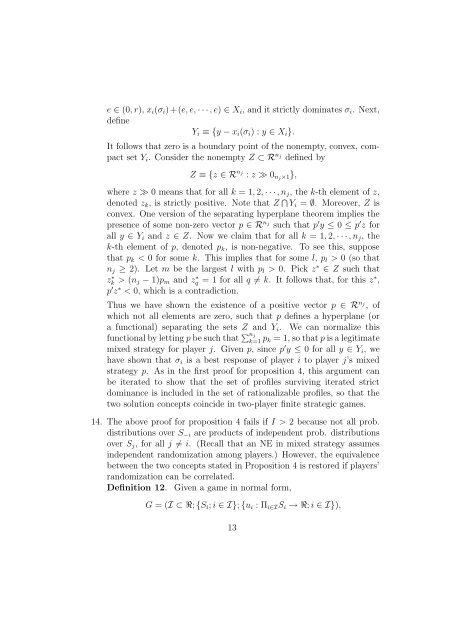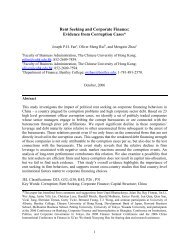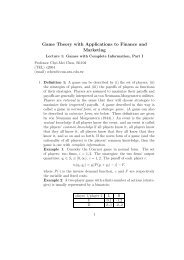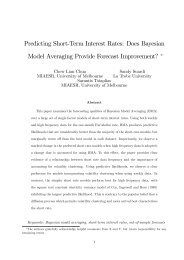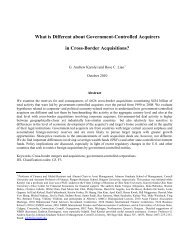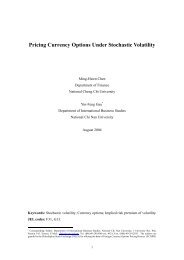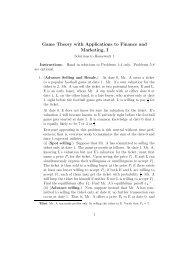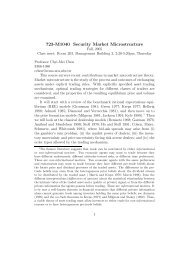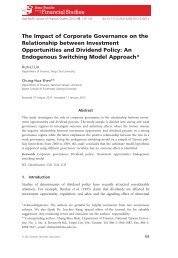Game Theory with Applications to Finance and Marketing
Game Theory with Applications to Finance and Marketing
Game Theory with Applications to Finance and Marketing
Create successful ePaper yourself
Turn your PDF publications into a flip-book with our unique Google optimized e-Paper software.
e ∈ (0, r), x i (σ i )+(e, e, · · · , e) ∈ X i , <strong>and</strong> it strictly dominates σ i . Next,<br />
define<br />
Y i ≡ {y − x i (σ i ) : y ∈ X i }.<br />
It follows that zero is a boundary point of the nonempty, convex, compact<br />
set Y i . Consider the nonempty Z ⊂ R n j<br />
defined by<br />
Z ≡ {z ∈ R n j<br />
: z ≫ 0 nj ×1},<br />
where z ≫ 0 means that for all k = 1, 2, · · · , n j , the k-th element of z,<br />
denoted z k , is strictly positive. Note that Z ⋂ Y i = ∅. Moreover, Z is<br />
convex. One version of the separating hyperplane theorem implies the<br />
presence of some non-zero vec<strong>to</strong>r p ∈ R n j<br />
such that p ′ y ≤ 0 ≤ p ′ z for<br />
all y ∈ Y i <strong>and</strong> z ∈ Z. Now we claim that for all k = 1, 2, · · · , n j , the<br />
k-th element of p, denoted p k , is non-negative. To see this, suppose<br />
that p k < 0 for some k. This implies that for some l, p l > 0 (so that<br />
n j ≥ 2). Let m be the largest l <strong>with</strong> p l > 0. Pick z ∗ ∈ Z such that<br />
zk ∗ > (n j − 1)p m <strong>and</strong> zq ∗ = 1 for all q ≠ k. It follows that, for this z∗ ,<br />
p ′ z ∗ < 0, which is a contradiction.<br />
Thus we have shown the existence of a positive vec<strong>to</strong>r p ∈ R n j<br />
, of<br />
which not all elements are zero, such that p defines a hyperplane (or<br />
a functional) separating the sets Z <strong>and</strong> Y i . We can normalize this<br />
functional by letting p be such that ∑ n j<br />
k=1 p k = 1, so that p is a legitimate<br />
mixed strategy for player j. Given p, since p ′ y ≤ 0 for all y ∈ Y i , we<br />
have shown that σ i is a best response of player i <strong>to</strong> player j’s mixed<br />
strategy p. As in the first proof for proposition 4, this argument can<br />
be iterated <strong>to</strong> show that the set of profiles surviving iterated strict<br />
dominance is included in the set of rationalizable profiles, so that the<br />
two solution concepts coincide in two-player finite strategic games.<br />
14. The above proof for proposition 4 fails if I > 2 because not all prob.<br />
distributions over S −i are products of independent prob. distributions<br />
over S j , for all j ≠ i. (Recall that an NE in mixed strategy assumes<br />
independent r<strong>and</strong>omization among players.) However, the equivalence<br />
between the two concepts stated in Proposition 4 is res<strong>to</strong>red if players’<br />
r<strong>and</strong>omization can be correlated.<br />
Definition 12. Given a game in normal form,<br />
G = (I ⊂ R; {S i ; i ∈ I}; {u i : Π i∈I S i → R; i ∈ I}),<br />
13


